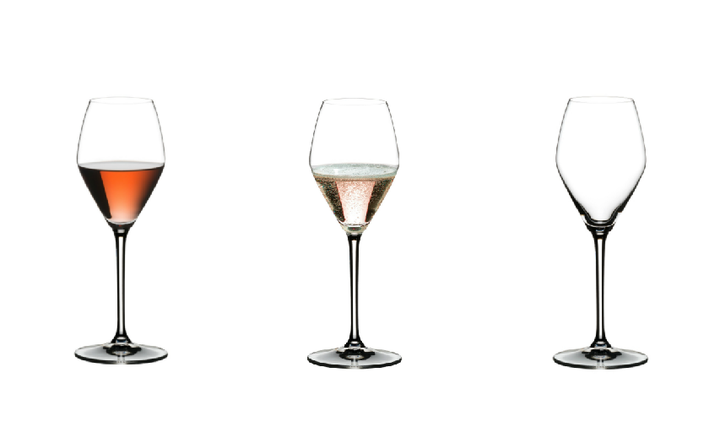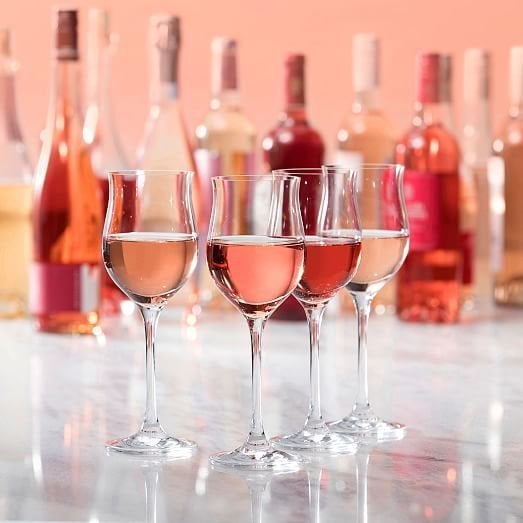
Rosé is more than a beverage: It’s an entire lifestyle for many of its fans. Instagram shots of beautifully labeled bottles, glowing against a sunset backdrop or shimmering in the sand, epitomize the best of summer.
But for all its popularity, rosé gets a lot of disrespect; often, the pink-hued sipper gets relegated to being served in plastic cups.
Glassware specialists such as Riedel are seeing an opportunity in the market and launching high-end, rosé-specific glasses that supposedly enhance the flavor of this wine. But does glassware truly make rosé taste any better or worse?
Here’s what the glasses claim to do
At first glance, Riedel’s Extreme Rosé glasses resemble tulip Champagne glasses. Their long, thin stems, wide midpoint and narrow opening bring to mind bubbles, but small differences are meant to take rosé to the next level.
This particular glass was the result of a four-year project involving the input of top Provencal winemakers and various focus groups. The resulting glass has a “diamond shape [that] creates a wider surface area at the midpoint of the glass, allowing a greater rate of alcohol’s evaporation, intensifying the wine’s fruit and floral aromas and silkiness as it enters the mouth,” Maximilian Riedel says. At $45 for a pair, it’s definitely an investment in the pink drink. Schott Zwiesel also offers a Rosé All Day glass. At $40 for a set of four, the rounder, fuller shape and flared lip purport to also bring out rosé’s aromatic properties.
The “are they worth it?” question really begins with if drinkers are ready to think about rosé as more than just an easygoing, warm-weather beverage. We talked to two sommeliers who think it’s time to see rosé transition from an ingénue into an Oscar-worthy role that’s deserving of its own glass.
Here’s what wine professionals think about rosé glasses
Josh Carlson, wine director at Provence Marinaside and The Wine Bar in Vancouver, Canada, doesn’t take his rosé list lightly. With an impressive 42 rosés offered by the glass, he aims to show the depth and breadth of the category and go beyond the ubiquitous pale Provencal style.
“We have almost too much rosé,” he says with a laugh, “but people seem to enjoy the options.”
Although discovery is part of his goal, he believes rosé should be taken seriously from a gastronomic perspective. “The way it reacts with food is quite exceptional and should be respected for the winemaking,” he said. “It’s refreshing, clean and can hit a lot of points that a white wine may not necessarily hit.”
“The olfactory senses are about 80 percent of the experience,” Carlson said, “so our nose integrates with our mouth and that’s where taste comes from. The shape of the glass really allows that sense to be affected.”
At Michelin-starred Aquavit in New York City, beverage manager Chris Clark fills out his 17-strong rosé selection with wines dating back to 2013. He strongly believes rosés from certain producers and varieties are age-worthy and he aims to break the stigma that all rosés need to be young to be enjoyable.
As a general guideline, both Carlson and Clark consider the varietal when selecting stemware. For instance, a rosé made with pinot noir grapes will be served in a pinot noir glass. However, there are no hard-and-fast rules.
“Certainly as we get new wines in and we think there’s a chance it might show better in something else, we always consider empirical evidence over what you think [the] traditional [choice] may be,” Clark notes.

So, yes, glass shape does matter. But, as there are glasses made for nearly every major variety, does the world need rosé-specific glasses?
Seminal producer Domaines Ott, which exclusively crafts high-end rosés, wants the category to become “a real third color of serious wine” and believes a proper vessel is needed to convey that.
“Just like great whites and great reds, great rosés are complex and need an elaborate glass to reveal their aromas,” winemaker Christian Ott wrote in an email. “Rosés need a wide bowl so they can swirl easily and exhale their fruity and floral notes. A narrow rim concentrates and guides those scents to the nose.” To wit, the winery only serves its wine in a shape it has dubbed the “Ott Glass.”
OK, so wine professionals think the glass makes a difference. But what about regular people?
In a restaurant setting, details such as proper glassware culminate into a special ambiance that’s expected when dining out. But is that level of minutiae important for the average rosé drinker?
In a highly unofficial taste test, HuffPost tried out the Extreme Rosé glasses with a variety of rosés, tested in both the Riedel and a standard all-purpose wine glass.
First up were two wines from Provence: M de Minuty, Chateau Minuty, 2017 and Mathilde Chapoutier Rosé, 2017. Both indeed showed amplified fruit and floral aromas in the rosé glass. We also tried the Chateau Romassan, Domaines Ott, 2016, to see how a slightly older vintage fared. Again, the fruit aromas were intensified in the rosé glass.
For contrast, we also tried two Spanish rosés: Txomin Etxaniz, Txacoli Rosé, 2017, which often showcases great saline and mineral characteristics, and El Coto Rioja Rosado, 2017, a fuller, riper style of rosé. While the Txacoli was complex and delicious on the palate, there wasn’t a discernible aromatic difference between glasses. However, the Rioja’s fruit was complemented and somewhat restrained with some savory notes in the Riedel glass.
There is also something to be said for the tactile sensation of holding the lightweight, thin-stemmed glass; it conveyed a sense of elegance for every wine poured.
“Certainly, I would always preface ‘does glassware matter’ with, ‘yes, of course, there’s always the minutiae of rosé and certainly it does matter,’” Clark says. “[However], I would qualify that statement by saying that if you’re chilling it down with friends and they may want a few ice cubes, I wouldn’t be opposed to drinking rosé out of a pint glass with a few ice cubes. I think part of the reason people enjoy rosé, especially in the summer, is because it’s easy and it’s not always a cerebral experience. It’s fun, refreshing, and hey, you do catch a little buzz.”
So it all depends on just how seriously you want to take your rosé. Are you in it for the long haul or just in it for a fling?